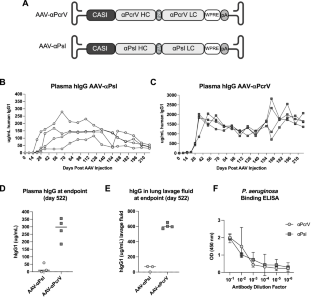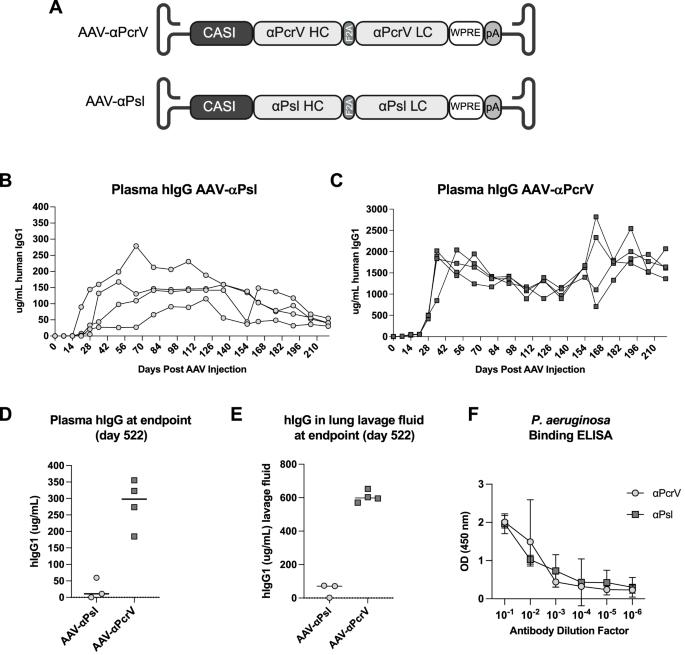通过 AAV 表达单特异性或双特异性单克隆抗体可保护小鼠免受致命性铜绿假单胞菌肺炎的感染
IF 4.6
3区 医学
Q1 BIOCHEMISTRY & MOLECULAR BIOLOGY
引用次数: 0
摘要
铜绿假单胞菌对免疫力低下的人和囊性纤维化患者构成重大威胁。治疗主要依靠抗生素,但由于铜绿假单胞菌对多种抗生素具有内在和获得性抗药性,因此会出现持续感染。迄今为止,还没有针对这种病原体的特许疫苗,因此迫切需要新的治疗方法来对抗铜绿假单胞菌感染和持续感染。在这里,我们验证了 AAV 媒介免疫预防法作为一种策略,可在小鼠模型中产生长期血浆和粘膜表达的高度保护性单克隆抗体 (mAb),其靶标是外多糖 Psl (Cam-003) 和 III 型分泌系统注射体的 PcrV (V2L2MD) 成分,既可作为单一 mAb,也可作为双特异性 mAb (MEDI3902)。肌肉注射 AAV-αPcrV、AAV-αPsl 和 AAV-MEDI3902 能显著保护经致命剂量铜绿假单胞菌 PAO1 株和 PA14 株鼻内注射的小鼠,并减少细菌负担和向其他器官的传播。虽然所有的 AAV-mAbs 都能提供保护,但 AAV-αPcrV 和 AAV-MEDI3902 在 4.47 × 107 CFU PAO1 的致死挑战中分别提供了 100% 和 87.5% 的保护,在 3 × 107 CFU PA14 的致死挑战中分别提供了 87.5% 和 75% 的保护。MEDI3902的血清浓度比αPcrV低约10倍,但与其他AAV-mAbs相比,用这种载体治疗的小鼠在肝脏、肺脏、脾脏和血液中的细菌扩散量减少得更多。这些结果支持进一步研究使用AAV载体免疫预防法来预防和治疗铜绿假单胞菌感染以及目前治疗策略有限的其他公共卫生问题细菌病原体。本文章由计算机程序翻译,如有差异,请以英文原文为准。


AAV-vectored expression of monospecific or bispecific monoclonal antibodies protects mice from lethal Pseudomonas aeruginosa pneumonia
Pseudomonas aeruginosa poses a significant threat to immunocompromised individuals and those with cystic fibrosis. Treatment relies on antibiotics, but persistent infections occur due to intrinsic and acquired resistance of P. aeruginosa towards multiple classes of antibiotics. To date, there are no licensed vaccines for this pathogen, prompting the urgent need for novel treatment approaches to combat P. aeruginosa infection and persistence. Here we validated AAV vectored immunoprophylaxis as a strategy to generate long-term plasma and mucosal expression of highly protective monoclonal antibodies (mAbs) targeting the exopolysaccharide Psl (Cam-003) and the PcrV (V2L2MD) component of the type-III secretion system injectosome either as single mAbs or together as a bispecific mAb (MEDI3902) in a mouse model. When administered intramuscularly, AAV-αPcrV, AAV-αPsl, and AAV-MEDI3902 significantly protected mice challenged intranasally with a lethal dose of P. aeruginosa strains PAO1 and PA14 and reduced bacterial burden and dissemination to other organs. While all AAV-mAbs provided protection, AAV-αPcrV and AAV-MEDI3902 provided 100% and 87.5% protection from a lethal challenge with 4.47 × 107 CFU PAO1 and 87.5% and 75% protection from a lethal challenge with 3 × 107 CFU PA14, respectively. Serum concentrations of MEDI3902 were ~10× lower than that of αPcrV, but mice treated with this vector showed a greater reduction in bacterial dissemination to the liver, lung, spleen, and blood compared to other AAV-mAbs. These results support further investigation into the use of AAV vectored immunoprophylaxis to prevent and treat P. aeruginosa infections and other bacterial pathogens of public health concern for which current treatment strategies are limited.
求助全文
通过发布文献求助,成功后即可免费获取论文全文。
去求助
来源期刊

Gene Therapy
医学-生化与分子生物学
CiteScore
9.70
自引率
2.00%
发文量
67
审稿时长
4-8 weeks
期刊介绍:
Gene Therapy covers both the research and clinical applications of novel therapeutic techniques based on a genetic component. Over the last few decades, significant advances in technologies ranging from identifying novel genetic targets that cause disease through to clinical studies, which show therapeutic benefit, have elevated this multidisciplinary field to the forefront of modern medicine.
 求助内容:
求助内容: 应助结果提醒方式:
应助结果提醒方式:


